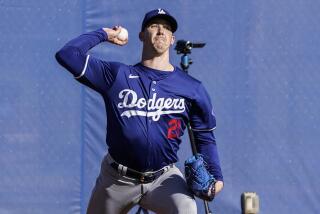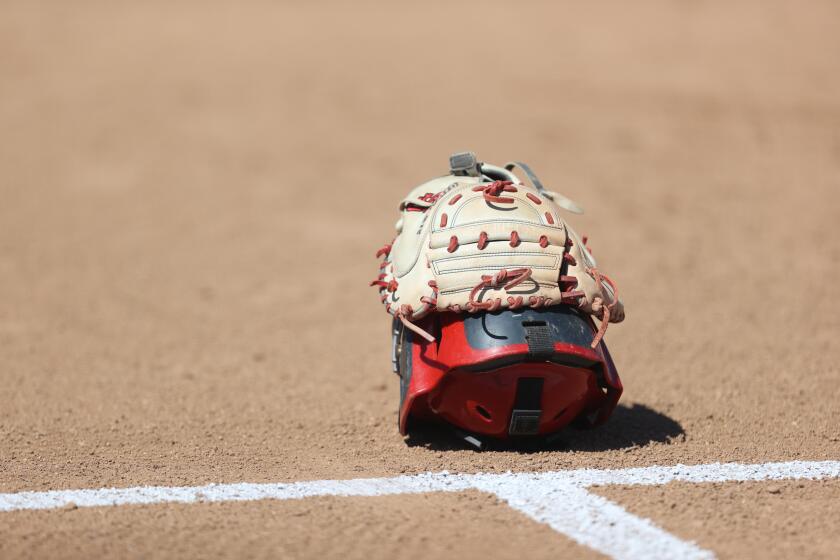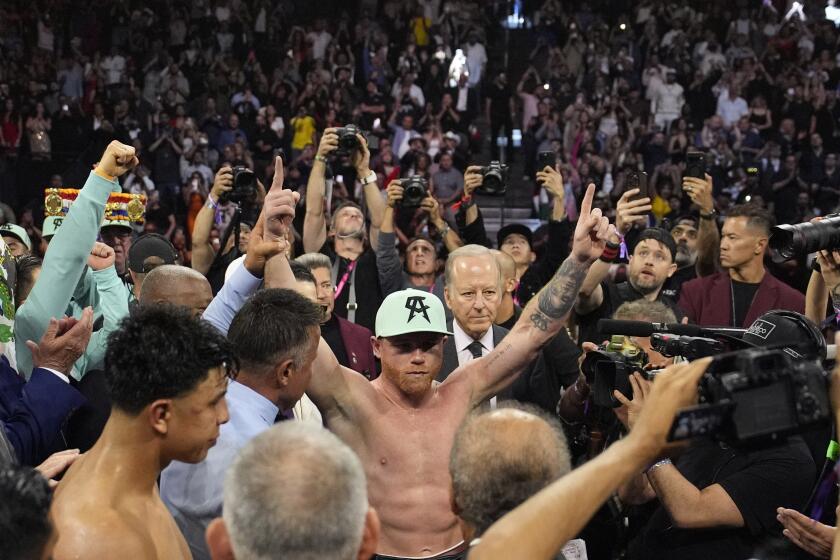Baseball’s Withdrawal Symptoms
Three years since its first steroid test, a year since its first suspension, three days since Commissioner Bud Selig sent former Sen. George Mitchell and his posse of lawyers after the stragglers, baseball doesn’t look as much like Barry Bonds’ game anymore.
Where once it outgrew its uniforms, an off-season at a time, baseball -- with help from Congress and its public -- has begun to outgrow its dependence on steroids.
Scouts, general managers and other player evaluators say the game is turning again, slowly, to a time when performance-enhancing drugs were other sports’ secrets.
“You keep hearing more names, and you see productivity fall off,” Dodger General Manager Ned Colletti said. “You start to wonder. I’ve heard a lot more names than I heard a year ago, two years ago. It was more prevalent than I believed it was, and you can’t just tie it to hitters and you can’t just tie it to superstars. You can tie it throughout a roster.
“I was actually surprised at some of the players who I was told, [and pitchers], the reason the performance is down is because [they were] juicing. Some of the names, some of the people, are shocking.”
So, as more of the players wean themselves from steroids and return to their natural body structures, there will be a premium on handling a glove, putting the ball in play, stealing a base, knowing the strike zone -- the skills a scout can measure.
“That type of player is going to come flying back,” Colletti said. “There’s a lot of players who were that type and were told at some point that the big money’s in power. Maybe they did something or didn’t do something, whatever, but felt they got left behind or changed their game.
“Now players can really be players again. They can be who they really are.”
And that, wouldn’t you know, presents a new issue: After more than a decade of evaluating players they knew or suspected were on steroids, or at the least separating the users from the abstainers, the game’s talent evaluators now measure the same generation of players coming off those drugs.
A National League scout laughed ruefully at the turnabout.
“Major League Baseball is trying like hell to identify this too,” he said. “If they can’t, how the hell am I going to find it?”
In recent summers, scouts would watch batting practice on warm evenings and take bets: Who was juicing, and who wasn’t?
“If you’re a decent scout, you should be able to tell,” said Eddie Bane, director of scouting for the Angels.
If the scouts couldn’t, the government could. It was in all the papers.
In one American League West organization, the same notation began to show up on scouting reports. Wryly, it read: “Congress got him,” and everyone knew the code: This is a player who has been scared off the juice, and it shows in his body and his performance.
“If you assume performance-enhancing drugs elevate performance, there hasn’t been much work on the other side of it,” said Mark Newman, senior vice president/baseball operations for the New York Yankees. “Who’s got that data?”
Dr. Gary Wadler, a leading authority on steroids in sports, was riding the train early one evening last week in New York. He had just opened the book “Game of Shadows,” which claims to chronicle Bonds’ and others’ routine use of anabolic and designer steroids. The question for Wadler was what happens when players come off.
“It’s a complicated question,” he said. “It depends on the dose, the duration, how vigorously you work out. The type of drug. I mean, some steroids’ effects go on for months. It depends where in the cycle of all this an individual may be. Was he a longtime user or a dabbler?”
Dr. Linn Goldberg, professor of medicine at Oregon Health & Science University, has testified about steroids before Congress. He has spent much of his career treating and talking to professional and amateur athletes about steroids. He has taken telephone calls from wives terrified their husbands were on steroids, one who discovered a vial with her husband’s uniform number on it, suggesting it was provided by the team, and spoken at length with athletes who’d come off steroids.
“They shrink,” he said.
Goldberg said he was unaware of any randomized studies measuring the effects of sustained steroid abuse followed by withdrawal. In his experience, he said, athletes lose weight, musculature and confidence, and then become depressed.
In baseball, he said, like in other sports, the players become weaker and most of their skills diminish to some degree, because muscle strength does not simply apply to hitting the ball farther or sustaining a swing or a fastball over the course of the season, but to promoting agility, quickness and self-assurance as well.
Their entire games change, but there is no way to quantify how much. Their lives change. He said a former NFL player stopped taking steroids and suffered sexual dysfunction for more than a year. His body was not producing testosterone.
“You can’t tell,” Goldberg said. “What you can do, take a look at baseball overall. Home runs are down significantly. For the individual, though, it’s very difficult to tell. If you were guessing, he’d be slower, weaker, smaller.”
The questions start at the most grass-roots levels. Newman, the Yankee senior vice president, says he suspects steroids are more prevalent among young players in Latin America, where the drugs are easier to come by.
Bane, the Angel scouting director, said he would support a plan to have the MLB Scouting Bureau drug-test the top prospects -- high school and college -- before each amateur draft. In the first months of baseball’s three-strikes-and-you’re-out steroid policy, and as general managers move to reemphasize baseball skills over uppercut swings with aluminum bats, it becomes more important than ever to identify the true player.
As Newman said, it would be counterproductive to sign a prospect for $1 million, “when $600,000 of it should go to his pharmacist.”
Though professional and amateur scouts had spent much of their professional lives attempting to fuse what they saw and what they believed, at least they’d come to trust that the player they saw today might resemble the player they see tomorrow. Steroids complicated their stand-by philosophies. The process that rid steroids challenged them more.
Now, in what baseball believes to be the post-steroid era, presumably a large percentage of players who used steroids in the late 1990s and early 2000s no longer take them. Some, presumably, discovered human growth hormone, which cannot be detected in baseball’s testing program. Others, perhaps, have jumped to designer steroids or the latest in masking agents.
But many general managers and scouts believe that most players -- hitters and pitchers -- who augmented their careers with drugs are now clean, and that it is changing the game, changing the way managers will manage, changing the way rosters are built and, by and large, making the scouts’ jobs more difficult than they’ve ever been.
“There’s no scientific way to know,” Colletti said. “It’s your eyes and it’s your intellect and it’s your intuition. It’s your scouts’ eyes, intellect and intuition. You’ve got to be able to say, ‘He’s not the same player. For whatever reason, he’s not the same player.’ ”
In 2005, 93 players tested positive for steroids and other banned substances, 81 of them in the minor leagues. Since, baseball has increased its penalties to 50 games for a first positive, 100 for a second positive and lifetime expulsion for a third. Between the players tossing their syringes, those avoiding borderline supplements and others driving their chemists to new levels of genius, evaluating players in the post-steroid era is beset with physical and psychological variables.
“It’s an inexact science,” San Diego Padre GM Kevin Towers said. “We deal with it every day out here.”
In their heads, and sometimes in their notebooks, they sorted the steroid users from the nonusers. They assumed the bulky players would stay bulky, for whatever reason, and they would know when the clean players crossed over, if they did. It was not a perfect vacuum, but scouts fly on instincts brought from decades around the game.
“You get a big picture, so you get a lot more to compare and contrast,” Dodger scout Mark Weidemaier said. “We’ll continue to gain a broader perspective from the guys that are on the juice and are now off it. But until you see them play, you don’t know. I don’t know if you can accurately gauge it. You just have to be aware of it.”
In the major leagues alone, bodies are changing again, and a few high-profile careers have ended abruptly.
One National League scout said that in spring training there were fewer right-handed hitters capable of hitting home runs to right-center field.
“Now,” he said, “they’re at the warning track.”
And bullpens, particularly middle relievers, have lost some of their fastball. Bane says he’s particularly wary of pitchers “who lost eight mph on the way to spring training.”
“You have to dig a little bit,” the National League scout said. “You have to ask around. Check with the beat writers, the coaches, something that will give you an indication.”
Ultimately, the players let them know if they will adjust their games and allow themselves to become the players they were before, or even settle for it.
“A lot of it is from a mental standpoint,” Towers said. “Guys that were users don’t have that natural edge. They’re not used to being naked out there. ... They no longer have that crutch. It’s almost like being a right-handed hitter for 10 years, and all of a sudden they make you hit left-handed.”
So the scouts will watch. It’s what they do. And they’ll let their bosses know when Congress got ‘em.
“It’s very difficult. I don’t know that we know yet,” Newman said. “In an uncertain world, this is another era of uncertainty.
“When you get down to it, the current policy will go a long way toward cleaning up the sport. Meantime, there’s no substitute for the discerning talent evaluator.”
More to Read
Get our high school sports newsletter
Prep Rally is devoted to the SoCal high school sports experience, bringing you scores, stories and a behind-the-scenes look at what makes prep sports so popular.
You may occasionally receive promotional content from the Los Angeles Times.






